
Original Link: https://www.anandtech.com/show/1682
Mushkin Redline XP4000: Winbond with Voltage Be Damned
by Wesley Fink on May 16, 2005 12:05 AM EST- Posted in
- Memory
OCZ started it all with their VX series memory. Combine Winbond die chips with voltages of up to 3.6V and you can likely reach over DDR500 at the fastest 2-2-2 timings. That grew into a successful line of OCZ VX memory that ranges from Value VX to a VX rated at DDR 500 2-2-2. Value VX impressed us with bang for the buck in our Value RAM roundup, and DDR500 2-2-2 VX is the fastest memory (in terms of bandwidth) that we have tested on the AMD Athlon 64 platform.
Now, Mushkin has introduced their own Winbond chip memory designed for high voltage and DDR500 2-2-2 performance. It's a natural fit for Mushkin, given their long working relationship with Winbond. It was only a matter of time until Mushkin managed to put together memory that could give the OCZ VX a run for the money.
Whoever at Mushkin came up with the Redline name should be congratulated. It's nice to see a memory with a catchy name instead of confusing model numbers with even more confusing naming schemes. Even the bright red heatspreader "says" Redline. But in the end, buyers grab the high voltage memory and a DFI nForce4 (or OCZ DDR Booster) for the performance. So, how does Mushkin Redline stack up in the all-important performance area?
Mushkin Redline XP4000
Mushkin has been providing High Performance memory modules since 1994. While they earned their reputation as an on-line retailer, today, you can buy Mushkin memory from many well-known retailers such as NewEgg, NCIX, AxionTech and many other sources. You can also buy Mushkin memory at their www.mushkin.com web site, where you will also find a wealth of information about Mushkin memory products.
It appears that Mushkin uses Winbond CH-die for their Redline memory, the same as OCZ. We say "appears" because most manufacturers using the Winbond UTT chips buy them as blanks and bin them for their speed ratings, so it is very difficult to identify exactly the chips used for the finished product. You can also find BH blanks on the market as well, and the finished product in either CH or BH depends mostly on the "speed-binning" capabilities of the memory manufacturer.
There was some confusion when Mushkin first announced the Redline series regarding the warranty coverage that would be provided, but Mushkin now clearly stands behind their Redline products with the same Lifetime Warranty that they provide for other Mushkin memory. However, Mushkin states that Active Memory cooling must be used with Redline modules for overclocking, and we agree.
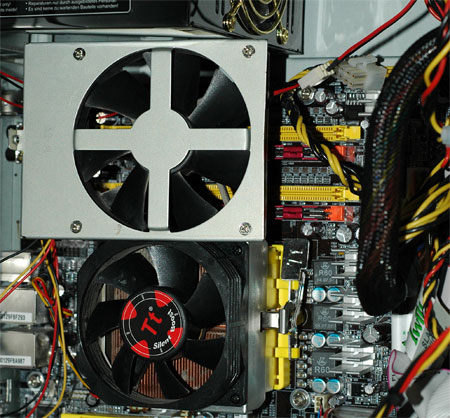
Mushkin provides some very sane advice in their Warranty for would-be overclockers of Redline memory:
"Our XP3500 REDLINE eliminates the memory as a potential bottleneck when overclocking. THE REDLINE MEMORY MODULES ARE DESIGNED TO RUN AT HIGHER VOLTAGES UP TO 3.5V AND SUFFICIENT COOLING IS A REQUIREMENT.
Active Cooling Required *----Due to the extreme speed of these modules along with the added voltages used, Mushkin requires end users to Actively cool their memory modules. Modules that are not properly cooled will/may not meet rated timings and speeds, and may become susceptible to premature failure. We generally recommend 15-25cfm of direct airflow over the ram modules which can be easily accomplished with one 60mm or 80mm low rpm fan. This will insure increased stability and lifespan of your Redline modules.
Recommended Platforms--- Mushkin tests all Redline memory modules on Athlon64 platforms. Furthermore, when running two modules, only Socket 939 platforms are validated to run at rated specifications/timings. We currently recommend and validate the Redline memory series on the DFI LanP arty UT NForce4 Ultra-D, DFI LanP arty UT NForce4 SLI-DR, and DFI LanP arty NForce4 SLI-DR boards as they provide the best combination of voltage options and compatibility for the Redline Series. Other motherboards may work, but may require modification for adequate voltages, and may not produce optimal results. Single Channel Athlon64 systems may have a hard time running 2x512mb dimms at rated speeds due to memory load on the single channel memory controller. Pentium4 and AthlonXP systems generally will not obtain rated specifications secondary to motherboard/memory controller limitations. These modules are compatible with most motherboards for Pentium4/AthlonXP CPUs, however end users are advised that lower frequencies achieved."
Mushkin Redline XP4000 Specifications
| Mushkin Redline XP4000 Memory Specifications | |
| Number of DIMMs & Banks | 2 DS |
| DIMM Size Total Memory |
512 MB |
| Rated Timings | 2-2-2-6 at DDR500 at 3.3-3.5V ACTIVE COOLING REQUIRED |
| SPD (Auto) Timings | 3-3-3-8 (Default 2.6V) |
| Rated Voltage | 3.3V to 3.5V |
With Intel's introduction last summer of the 915/925X chipsets with support for DDR2 memory, the primary market for DDR memory has become the excellent AMD Athlon 64 platform. This has been reinforced with the recent 945/955x Intel chipsets, which also use DDR2 memory. It is true that some 915 boards also support DDR, and the continuing Intel Socket 478 also supports DDR memory, but the primary market for DDR memory is now the AMD Athlon 64 platform.
It is worth noting that Mushkin warrants Redline performance only for AMD Athlon 64 socket 939 motherboards. Mushkin tells us that the Redline memory may work fine in Intel motherboards at lower voltages, but it is not tested or specified for Intel DDR platforms. In addition, the only unmodified motherboard that can supply the voltages required for top Redline performance is the DFI nForce4 motherboard. For these reasons, Mushkin Redline memory was only tested on the DFI LANParty nF4 SLI-DR Athlon 64 Socket 939 test bed.
Performance Test Configuration
The Mushkin Redline XP4000 was tested with the DFI LANParty nF4 SLI-DR Athlon 64 Socket 939 motherboard. The DFI nForce4 SLI and Ultra are the only current production boards that support the 3.3V to 3.5V rated voltages required for Redline DDR500 performance. An OCZ DDR Booster can be used with motherboards without support for high memory voltages. Other components remain the same as used in the memory setup in Athlon 64 Memory: Rewriting the Rules.The A64 test bed includes components that have been proven in Socket 939 Athlon 64 benchmarking, such as the Socket 939 4000+, and the OCZ Power Stream 520 Power Supply. Since the Athlon 64 tests represent a new series of DDR testing, we have chosen the current generation NVIDIA 6800 Ultra video card for benchmarking. We have found the 6800 Ultra to be a particularly good performance match to NVIDIA motherboards.
All other basic test conditions attempted to mirror those used in our earlier Intel memory reviews. However, test results are not directly comparable to tests performed on the Intel test bed.
| AMD nForce4 Performance Test Configuration | |
| Processor(s): | AMD 4000+ (FX53) Athlon 64 (2.4GHz, Socket 939, 1 MB cache, Dual Channel, 1000HT) |
| RAM: | Mushkin Redline XP4000 (DS) 2X512MB Kingston KVR400X64C25/512 (DS) 2X512MB Kingston KVR400X64C3AK2/1G (DS) 2X512MB Mushkin PC3200 EM (DS) 2X512MB OCZ PC3200 Value Series (VX) (DS) 2X512MB OCZ PC3200 Gold (BH5) (DS) 2X512MB OCZ PC3200 Premier (DS) 2X512MB Transcend JM366D643A-50 (DS) 2X512MB Patriot PC3200+XLBT (DS) 2X512MB OCZ EL PC4000 VX Gold (DS) 2X512MB Corsair TwinX1024-4400C25 (DS) 2X512MB Crucial Ballistix (DS) 2X512MB OCZ PC3200 Platinum Rev 2 (DS) 2X512MB |
| Hard Drives: | Seagate 120GB SATA 7200RPM 8MB Cache |
| PCI/AGP Speed: | Fixed at 33/66 |
| Bus Master Drivers: | NVIDIA nForce Platform Driver 6.53 |
| Video Card(s): | NVIDIA 6800 Ultra 256MB PCIe, 256MB aperture, 1024x768x32 |
| Video Drivers: | NVIDIA Forceware 71.89 Release |
| Power Supply: | OCZ Power Stream 520W |
| Operating System(s): | Windows XP Professional SP2 |
| Motherboard: | DFI LANParty nF4 SLI-DR |
| BIOS: | 3/10/2005 Release |
In past benchmarking, we have found performance of the nForce4 and nForce3 chipsets to be virtually identical, and we have found AGP and PCIe performance to be virtually the same in the benchmarks that we use for memory testing. Therefore, you can also generally compare these results to TCCD benchmarks in recent memory reviews.
With nForce3 motherboards, the fastest performance on AMD Athlon 64 was at a Cycle Time or tRAS of 10. However, the nForce4 behave a bit differently with memory. We ran a complete set of Memtest86 benchmarks with only tRAS varied to determine the best tRAS setting for these memories, and found the best bandwidth at tRAS settings ranging from 5 to 8. Therefore, a tRAS setting of 6 was used for testing.
Test Settings
All AMD Athlon 64 processors are unlocked downward, and the FX CPUs are unlocked up and down. This feature allows a different approach to memory testing, which truly measures performance differences in memory speed alone. All tests were run with CPU speed as close to the specified 2.4GHz of the 4000+/FX53 as possible, with CPU speed/Memory Speed increased at lower multipliers to achieve 2.4Ghz. This approach allows the true measurement of the impact of higher memory speed and timings on performance, since CPU speed is fixed, thereby removing CPU speed as a factor in memory performance.The following settings were tested with the Mushkin Redline XP4000 on the DFI nF4 test bed:
- 2.4GHz-12x200/DDR400 - the highest stock memory speed supported on VIA 939/nF3-4/SiS755-FX motherboards
- 2.4GHz-11x218/DDR436 - a ratio near the standard DDR433 speed
- 2.4GHz-10x240/DDR480 - a ratio near the standard rating of DDR466
- 2.4GHz -9x267/DDR533 - a memory speed achieved by only a few top memories on the Athlon 64
- Highest Memory Performance - the highest memory bandwidth and game performance that we could achieve with the memory being tested; this is rarely the highest memory speed that we could achieve. It is normally a lower speed with 1T Command Rate and tighter memory timings.
We ran our standard suite of memory performance benchmarks: Quake 3, Return to Castle Wolfenstein-Enemy Territory-Radar, Super Pi 2M, and Sandra 2004 Standard and UnBuffered. We also included Everest Home Edition memory tests, free at www.lavalys.com, for read speed, write speed, and Latency.
Test Results: Mushkin Redline XP4000
The top row of Performance results at 2.6V is included as a performance baseline. Like OCZ VX, Mushkin Redline cannot achieve 2-2-2 timings at stock voltage at DDR400. However, it can easily reach 2-2-2 performance levels at DDR400 with more voltage.| Mushkin Redline XP4000 (DDR500) - 2x512Mb Double-Bank | |||||||
| CPU Ratio at 2.4GHz | Memory Speed |
Memory Timings & Voltage |
Quake3 fps |
Sandra UNBuffered | Sandra Standard Buffered |
Super PI 2M places (time in sec) |
Wolfenstein - Radar - Enemy Territory fps |
| 12x200 | 400 DDR (Stock Voltage) |
2-3-2-6 2.6V 1T (Stock Voltage) |
565.4 | INT 2719 FLT 2866 |
INT 6111 FLT 6056 |
81 | 119.9 |
| 12x200 | 400 DDR | 2-2-2-6 3.0V 1T |
572.5 | INT 2745 FLT 2899 |
INT 6127 FLT 6071 |
81 | 119.8 |
| 11x218 | 436 DDR | 2-2-2-6 3.1V 1T |
578.0 | INT 2912 FLT 3079 |
INT 6512 FLT 6435 |
80 | 120.2 |
| 10x240 | 480 DDR | 2-2-2-6 3.2V 1T |
591.7 | INT 3037 FLT 3293 |
INT 6775 FLT 6700 |
79 | 122.7 |
| 9x267 | 533 DDR | 2-2-2-6 3.4V 1T |
599.1 | INT 3308 FLT 3521 |
INT 7125 FLT 7032 |
78 | 124.0 |
| 9x272 (2.45GHz) |
Highest Mem Speed 538 DDR |
2-2-2-6 3.5V 1T |
612.3 | INT 3410 FLT 3592 |
INT 7260 FLT 7183 |
77 | 127.2 |
| 10x272 (2.72GHz) |
Highest CPU/Mem Performance | 2-2-2-6 3.5V 1T |
656.5 | INT 3493 FLT 3697 |
INT 7701 FLT 7605 |
71 | 139.0 |
We reached an extremely stable DDR400 2-2-2-6 at 3.0V with Mushkin Redline XP4000. We then maintained 2-2-2-6 timings all the way to DDR546, which required 3.5V for complete stability. The voltage requirements from 3.0 to 3.6 volts were very linear to Memory Speed. DDR544 is the highest speed that we have ever reached with 2-2-2 timings, but it is only slightly more than the DDR538 2-2-2 achieved in our tests of the OCZ VX. Since both memories use the same memory chips, it appears that Mushkin and OCZ are both doing a similarly excellent job in binning the Winbond chips for their DDR500 2-2-2 products.
The important results here are rows 1 to 6, where CPU speed is kept at 2.4GHZ and only the Memory Speed is varied. The performance differences that you see in that range are a result of Memory Speed only. Since the Mushkin Redline also maintained constant 2-2-2-6 timings across the performance tests, the performance improvements are completely a result of memory speed only. It is not a huge difference in real-world benchmarks, compared to the huge increase in synthetic benchmarks like Sandra, but the increase is real nonetheless.
When you compare results of Mushkin Redline or OCZ VX, you will also see that all 2-2-2 is not created equal. Winbond and the revived BH5 are just a bit faster than other 2-2-2 memory at the same memory speed. Again, the difference is not huge, but where a computer enthusiast is aiming for top competitive scores, every advantage carries weight.
Performance Comparisons
Performance of the Mushkin Redline XP4000 was compared to all of the memory recently tested on the AMD Athlon 64 platform. We did not test on an Intel platform, since the last two generations of Intel chipsets have supported DDR2 instead of DDR memory. However, the AMD results can also be generally compared to previous benchmark results on the Intel 875 memory test bed. More results are available in recent DDR memory reviews:Value RAM Roundup: Computing On a Budget
Patriot DDR400 2-2-2/DDR533 3-4-4: Performance AND Value
OCZ VX Revisited: DDR Updates on DFI nForce4
OCZ VX Memory + DFI nForce4 = DDR533 at 2-2-2
Corsair 4400C25: Taking Samsung TCCD to New Heights
PQI & G. Skill: New Choices in 2-2-2 Memory
Athlon 64 Memory: Rewriting the Rules
OCZ 3700 Gold Rev. 3: DDR500 Value for Athlon 64 & Intel 478
Geil PC3200 Ultra X: High Speed & Record Bandwidth
= F-A-S-T= DDR Memory: 2-2-2 Roars on the Scene
Buffalo FireStix: Red Hot Name for a New High-End Memory
New DDR Highs: Shikatronics, OCZ, and the Fastest Memory Yet
The Return of 2-2-2: Corsair 3200XL & Samsung PC4000
OCZ 3700EB: Making Hay with Athlon 64
OCZ 3500EB: The Importance of Balanced Memory Timings
Mushkin PC3200 2-2-2 Special: Last of a Legend
PMI DDR533: A New Name in High-Performance Memory
Samsung PC3700: DDR466 Memory for the Masses
Kingmax Hardcore Memory: Tiny BGA Reaches For Top Speed
New Memory Highs: Corsair and OCZ Introduce DDR550
OCZ PC3700 Gold Rev. 2: The Universal Soldier
OCZ 4200EL: Tops in Memory Performance
Mushkin PC4000 High Performance: DDR500 PLUS
Corsair TwinX1024-4000 PRO: Improving DDR500 Performance
Mushkin & Adata: 2 for the Fast-Timings Lane
Searching for the Memory Holy Grail - Part 2
Memory Performance Comparisons
For consistency, memory performance was only compared to other memory tested on the DFI nForce4 memory test bed. Test results were compared at 200x12 (2.4Ghz, DDR400), 218x11 (2.4Ghz, DDR438), 240x10 (2.4Ghz, DDR480), 267x9 (2.4Ghz, DDR533), and the Highest Memory Performance that we could reach. With a constant CPU speed, memory comparisons (except for top-speed and performance) show the true impact of faster speed and slower memory timings on memory performance.DDR400/2.4GHz Performance
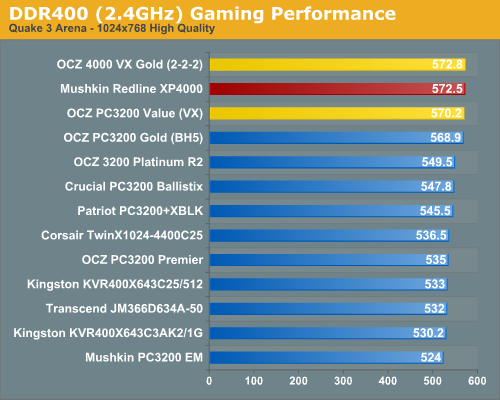
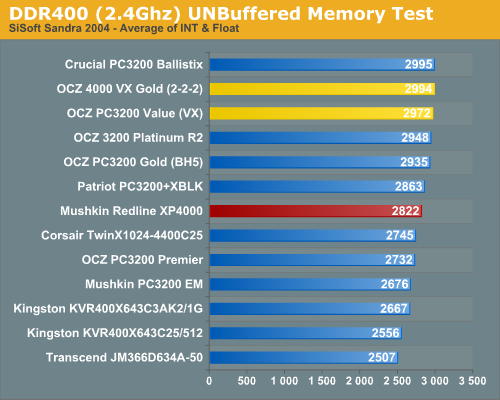
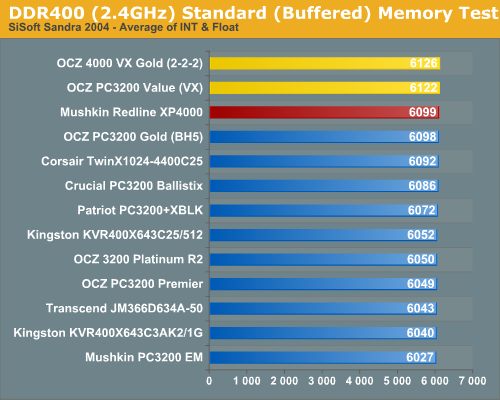
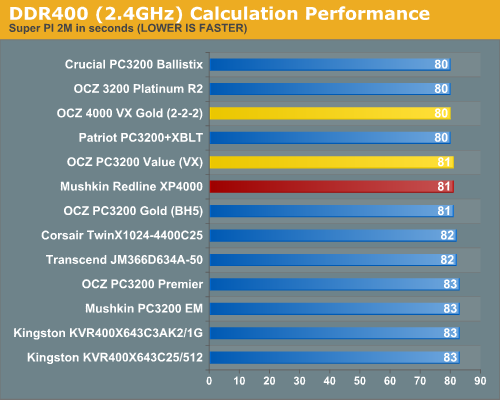
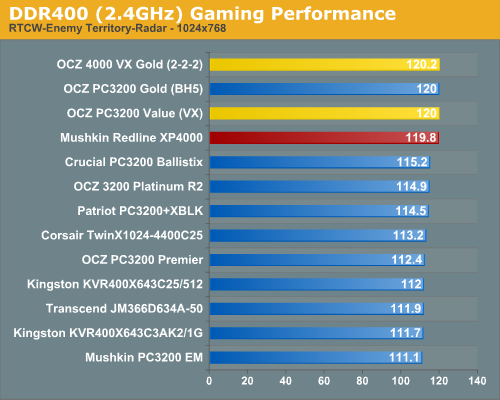
DDR436/2.4GHz Performance
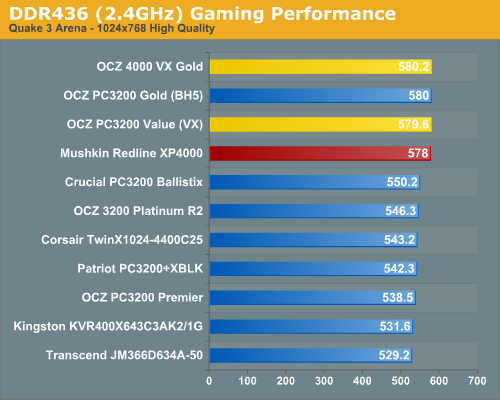
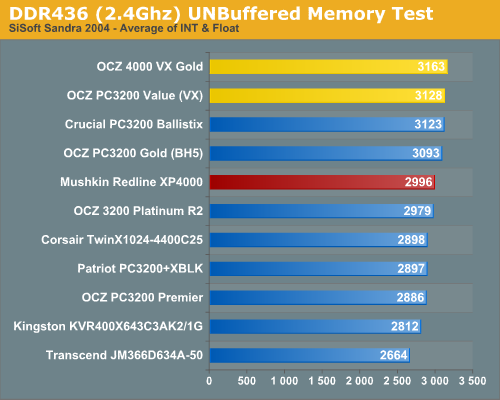
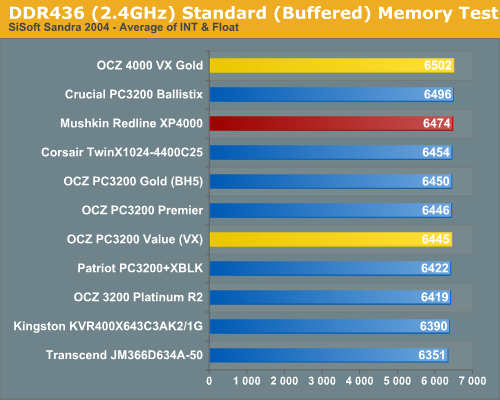
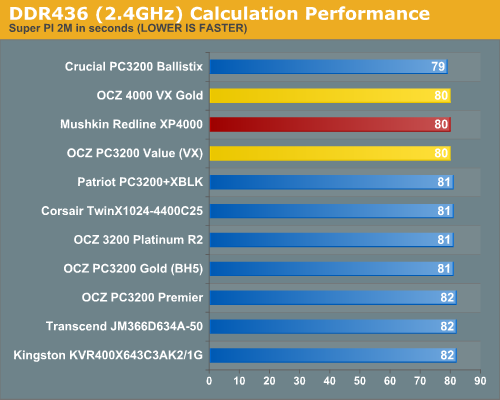
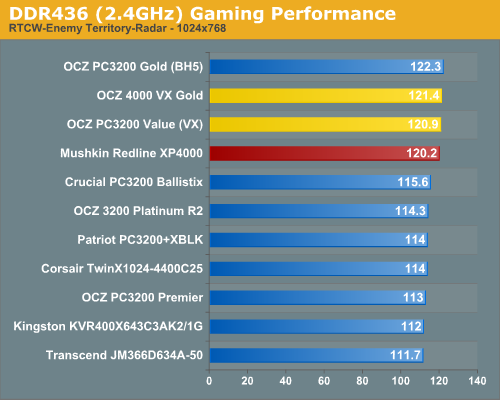
DDR480/2.4GHz Performance
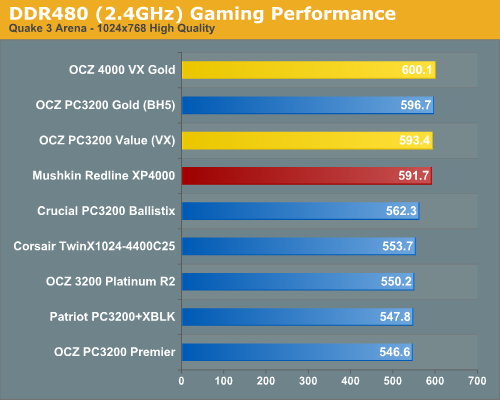
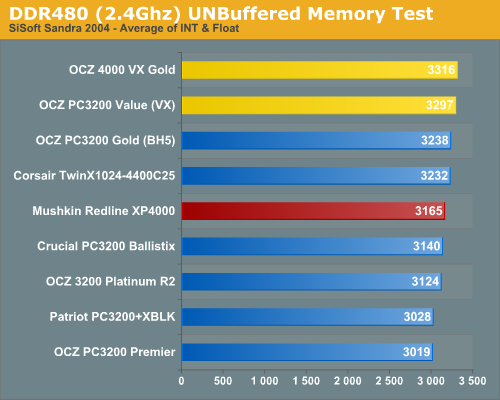
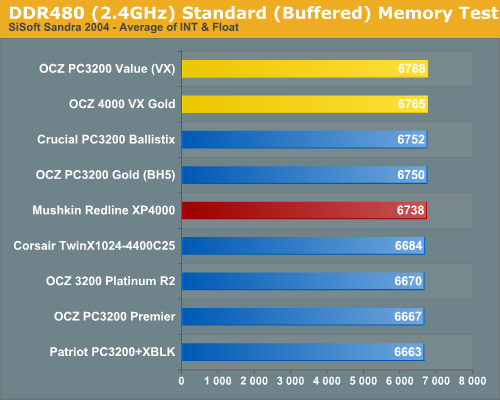
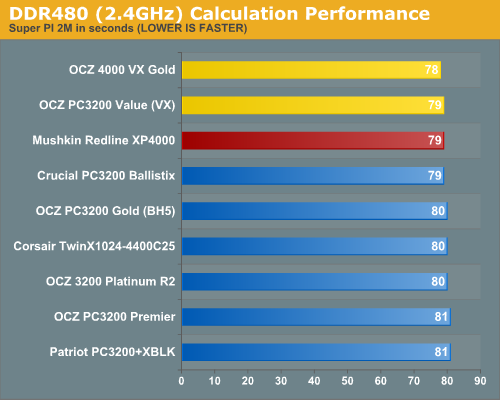
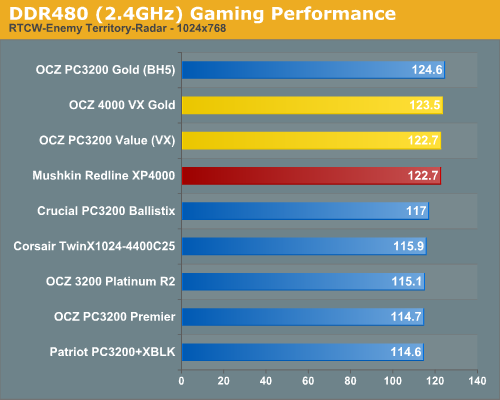
DDR533/2.4GHz Performance
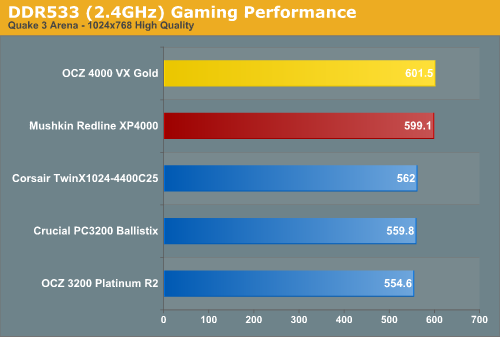
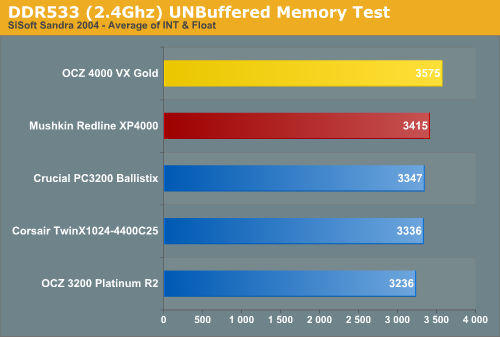
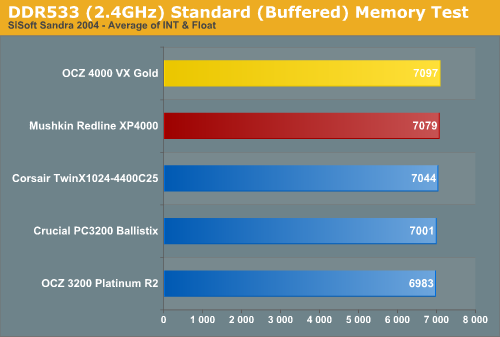

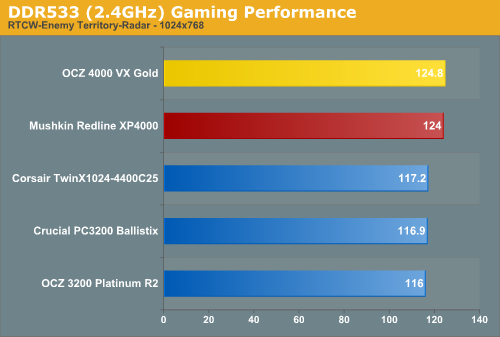
Highest Performance
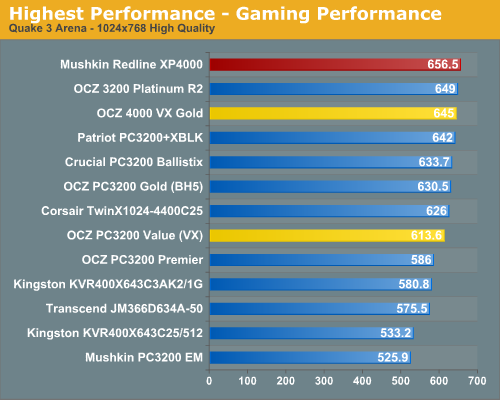
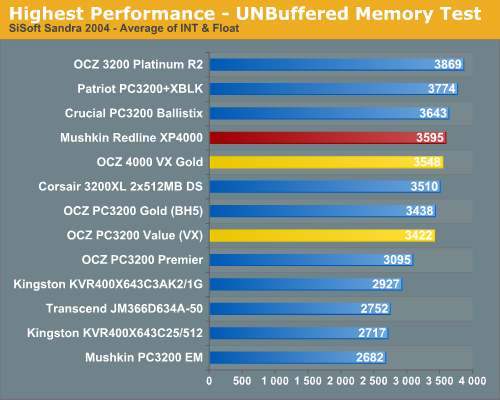

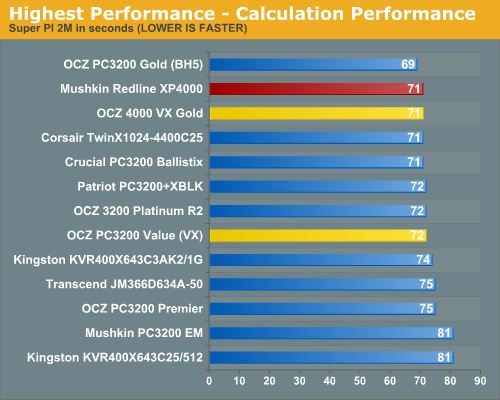
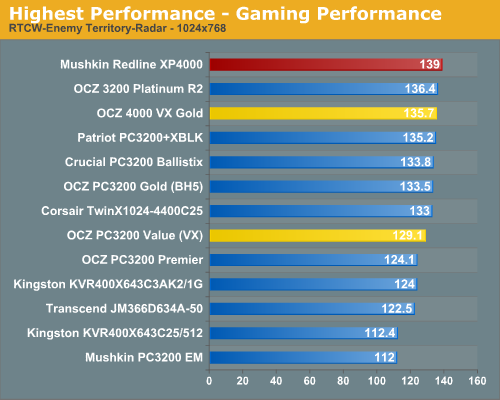
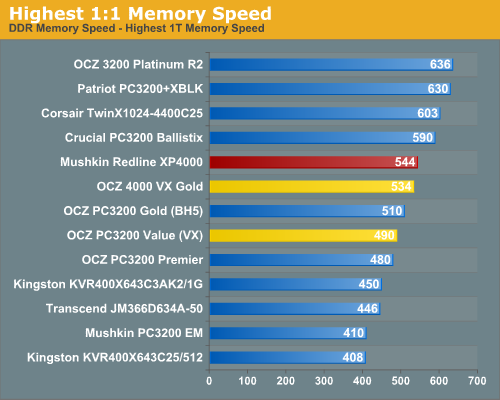
Final Words
OCZ may have been first to market with high voltage 2-2-2 memory, but Mushkin Redline XP4000 competes very well with the top OCZ VX Gold PC4000. Mushkin is clearly doing a very good job of binning the Winbond UTT chips, since performance in every area was as good as, or slightly better, than the OCZ that we tested a few weeks ago.It is not faint praise to say that the Mushkin Redline we tested was at least the equal of OCZ VX Gold 4000 – the fastest DDR memory that we have tested up to this point. Mushkin Redline is a quality memory, which is the important point of this review. The Mushkin is actually the fastest DDR memory that we have ever tested at 2-2-2 timings, edging out OCZ at the top at DDR544 compared to DDR538. However, it would be a mistake to make too much of this, since the performance seen from OCZ VX Gold 4000 and Mushkin Redline XP4000 was virtually identical. The variations between them were what you would find as normal variations with any two memories using the same chips from lines using similar binning strategies.
Mushkin Redline XP4000 is some of the fastest memory that you can buy, but it requires special handling that will not be everyone’s cup of tea. You need to feed it about 3.5V for best performance. Only one production board family supplies those voltages out of the box – the DFI nForce4 series Ultra or SLI. If you want to use another board, you may be able to use the OCZ DDR Booster, which costs about $40, to supply the higher voltages. The DDR Booster won’t work on every motherboard, but it does work on most. Or lastly, you could go on Enthusiast Forums to find the latest volt mod for your favorite motherboard. Just keep in mind that a volt mod will almost surely void your warranty.
If these options don’t scare you away, then get ready for some outstanding performance with either Mushkin Redline XP4000 or OCZ VX Gold 4000. There are no other options that can deliver 2-2-2 DDR memory timings at almost DDR550 speed. It takes voltage to get there, but you can be sure that your memory performance is as good as it will get.
If, on the other hand, the options for reaching 3.5V frighten you or really are not something that interests you, then move on to another memory. Mushkin Redline and OCZ VX are not for everyone. There are many readers who will think all this effort is a waste of time and resources, and they should select another memory. That is why there are complete systems, separate components, a wide range of component performance levels, and Dell and HP, all serving the computer market. Not everyone has the same goals, interests or passions for computer technology.
Mushkin Redline XP4000 clearly delivers what it promises to the Computer Enthusiast. If that level of performance is what you’re looking for, and you’re willing to provide 3.5V of memory voltage, then you will be very satisfied with Mushkin Redline memory.







